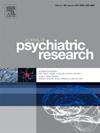Prediction of post stroke depression with machine learning: A national multicenter cohort study
IF 3.7
2区 医学
Q1 PSYCHIATRY
引用次数: 0
Abstract
Objective
Post-stroke depression (PSD) is a common psychiatric complication following stroke, with low clinical detection rates and delayed diagnosis. Most existing PSD prediction models suffer from incomplete data inclusion, which limits their clinical predictive value. This study aims to integrate multimodal data, including clinical characteristics, biomarkers, and neuroimaging variables, to validate the potential of machine learning models in efficiently identifying high-risk PSD patients.
Methods
This study is based on a multicenter clinical follow-up cohort of patients with acute ischemic stroke (AIS) in China, conducted from December 2020 to September 2023. Predictive factors included demographic characteristics, clinical features, and previously identified neuroimaging variables associated with PSD. The primary outcome was the occurrence of PSD within 3–6 months after stroke. The dataset was divided into a training set and a test set at a 3:1 ratio, with further validation performed using an external dataset. Four machine learning models—Adaptive Boosting, Gradient Boosting Decision Tree (GBDT), Quadratic Discriminant Analysis, and Multilayer Perceptron Classifier—were implemented using Python. Their predictive performance was compared based on accuracy metrics.
Results
A total of 4298 AIS patients (mean age: 68.33 ± 8.82 years, 46.4 % male) were included, among whom 1483 developed PSD. In the test dataset, the GBDT model achieved an area under the curve (AUC) of 0.8626, accuracy of 0.7833, sensitivity of 0.8085, specificity of 0.5296, and an F1-score of 0.6396, outperforming other models. In the external validation set, the GBDT model also demonstrated superior performance, with an AUC of 0.8185, accuracy of 0.8636, sensitivity of 0.8846, specificity of 0.5285, and an F1-score of 0.6689. The most important predictors of PSD included National Institutes of Health Stroke Scale (NIHSS) at discharge, left-sided lesions, lacunar infarcts (LIs), homocysteine (HCY) levels, and systolic blood pressure (SBP).
Conclusion
The machine learning model performs well in predicting PSD. Clinicians should focus on stroke patients with high NIHSS scores, left-sided lesions, LIs, elevated HCY level, and high SBP to develop personalized and precise management and treatment strategies for high-risk PSD patients, aiming to prevent or delay PSD onset.
用机器学习预测脑卒中后抑郁:一项国家多中心队列研究
目的脑卒中后抑郁(PSD)是脑卒中后常见的精神并发症,临床检出率低,诊断滞后。现有的PSD预测模型大多存在数据不完整的问题,限制了其临床预测价值。本研究旨在整合多模式数据,包括临床特征、生物标志物和神经影像学变量,以验证机器学习模型在有效识别高风险PSD患者方面的潜力。方法本研究基于2020年12月至2023年9月对中国急性缺血性卒中(AIS)患者进行的多中心临床随访队列。预测因素包括人口学特征、临床特征和先前确定的与PSD相关的神经影像学变量。主要终点是卒中后3-6个月内PSD的发生。数据集以3:1的比例分为训练集和测试集,并使用外部数据集进行进一步验证。使用Python实现了自适应增强、梯度增强决策树(GBDT)、二次判别分析和多层感知器分类器四个机器学习模型。他们的预测性能基于准确性指标进行比较。结果共纳入AIS患者4298例(平均年龄68.33±8.82岁,男性46.4%),其中发生PSD的患者1483例。在测试数据集中,GBDT模型的曲线下面积(AUC)为0.8626,准确率为0.7833,灵敏度为0.8085,特异性为0.5296,f1评分为0.6396,优于其他模型。在外部验证集中,GBDT模型的AUC为0.8185,准确率为0.8636,灵敏度为0.8846,特异性为0.5285,f1评分为0.6689。PSD最重要的预测指标包括出院时美国国立卫生研究院卒中量表(NIHSS)、左侧病变、腔隙性梗死(LIs)、同型半胱氨酸(HCY)水平和收缩压(SBP)。结论机器学习模型对PSD有较好的预测效果。临床医生应重点关注NIHSS评分高、左侧病变、LIs、HCY水平升高、收缩压高的脑卒中患者,针对高危PSD患者制定个性化、精准的管理和治疗策略,以预防或延缓PSD的发生。
本文章由计算机程序翻译,如有差异,请以英文原文为准。
求助全文
约1分钟内获得全文
求助全文
来源期刊

Journal of psychiatric research
医学-精神病学
CiteScore
7.30
自引率
2.10%
发文量
622
审稿时长
130 days
期刊介绍:
Founded in 1961 to report on the latest work in psychiatry and cognate disciplines, the Journal of Psychiatric Research is dedicated to innovative and timely studies of four important areas of research:
(1) clinical studies of all disciplines relating to psychiatric illness, as well as normal human behaviour, including biochemical, physiological, genetic, environmental, social, psychological and epidemiological factors;
(2) basic studies pertaining to psychiatry in such fields as neuropsychopharmacology, neuroendocrinology, electrophysiology, genetics, experimental psychology and epidemiology;
(3) the growing application of clinical laboratory techniques in psychiatry, including imagery and spectroscopy of the brain, molecular biology and computer sciences;
 求助内容:
求助内容: 应助结果提醒方式:
应助结果提醒方式:


